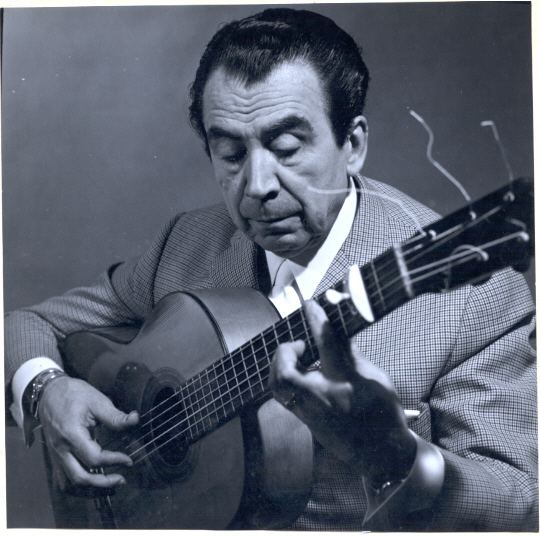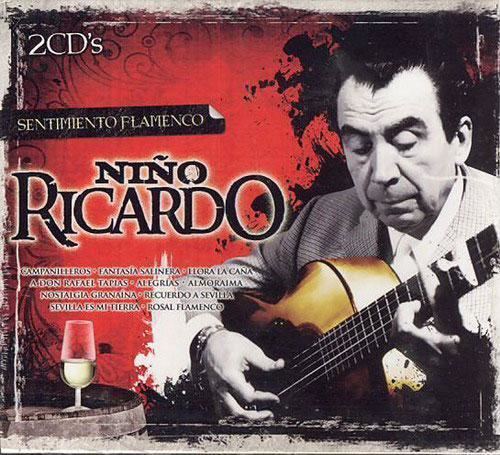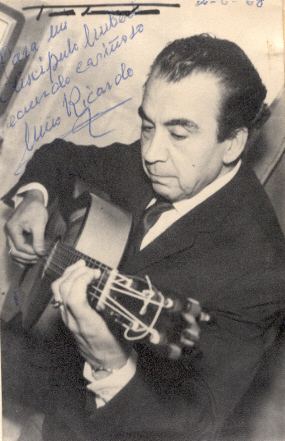Name Nino Ricardo | Role Composer | |
 | ||
Albums Toques Flamencos de Guitarra Similar People Ramon Montoya, La Nina de los Peines, Melchor de Marchena, Manolo Caracol, Juanito Valderrama | ||
Ni o ricardo
Niño Ricardo (11 July 1904 – 14 April 1972), born as Manuel Serrapí, was a Flamenco composer, considered by some sources as the most accomplished flamenco player of his day. He played a significant part in the evolution of the flamenco guitar. He lived in the city center of Sevilla. A child guitar prodigy, his early audiences referred to him as the son of Ricardo, leading to his stage-name Niño [de] Ricardo.
Contents
- Ni o ricardo
- Ni o ricardo buler as
- Early years
- Playing style
- Musical influences
- Personal life
- Death
- Legacy
- Partial Filmography
- Partial Discography
- Songs
- References

Ni o ricardo buler as
Early years

He was born on July 11, 1904, on Almudena Street of the Plaza de Argüelles in Seville (today Plaza del Cristo de Burgos), in Spain, in a typical neighborhood at that time. Today visitors contemplate the facade of the hotel which is dedicated to Niño Ricardo with a commemorative plaque.

Serrapí Ricardo Torres, guitarist and father of Niño Ricardo along with Antonio Moreno, a friend of the father, taught and introduced young Ricardo to the world of flamenco when he was 13 years old. Like his father, he did not want to play professionally.

Javier Molina, guitarist born in Jerez, was the one who gave the first opportunity to Niño Ricardo, at 14 years of age, to perform in a flamenco show, where he met singers whom he later accompanied both in Spain and beyond, and concert performance continued uninterrupted for the rest of his life. His career began in 1924 by accompanying La Niña de los Peines and at the age of 20 he began recording on his own.
Playing style
His fingernails grew in a peculiar upward curve, a fact that influenced his playing style and tone. After a throat operation in 1945, he acquired a deep, raspy voice that is audible on recordings in which he hums along and offers encouraging remarks to the singer.
His bright chord arrangements with the left hand together with his creative genius made for his own unique falsetas (improvisations). His right hand was unique in its constant manipulation of the strings and insistent rhythmic counterpoint. The Ricardo touch carried such musical motivation that many singers acknowledged they never sang better than with his accompaniment. He also loved accompaniment and was fond of singing before a concert with his guitar and because he sang to his guitar, he encouraged others to join in..
He was one of the wisest players in flamenco history, and gave each song form its rightful place. He claimed that the guitar was his religion. He said the guitar with singing, should carry on a dialogue: "Neither should the singing silence the guitar nor the guitar obscure the passage of the cante (singing)". Flamenco guitar would not be what it is, if it were not for the Master.. The totally new style he developed revolutionized the guitar, creating a school called the 'Ricardismo' (very much Ricardo). He introduced a new challenge to the art of flamenco guitar playing at the time.
Musical influences
Ricardo was influenced by fellow flamenco players, including: Pinto, Torre, El Niño Gloria, Escacena, and Antonio Mairena. He spent his early years playing in the taverns and bars of Seville where he developed his own personal style and created much of his own material. He was inspired by the great threesome of flamenco guitar; Ramón Montoya, Manolo de Huelva, and Javier Molina, by whom he was guided at the start of his professional career in the Salon Variedades in Seville. Ricardo recorded with many singers, including Pastora, El Carbonerillo, Mazaco, Antonio and Manuel Mairena, Fernanda y Bernarda, Caracol and Talega.
Personal life
Born as Manuel Serrapí on 11 July 1904, he was one of two children. The son of Ricardo and Carmen Serrapí, he was born in southern Spain and began playing guitar as a young child. He married Lola Siguenza in his early twenties and had two children with her. He reportedly had several affairs with other women while touring, thus there are two more children he is considered to be the father of.
In 1945 he underwent throat surgery that left him with a deep voice, although this did not prevent him from continuing his career; he is easily recognized in the recordings where one can hear him humming along as he plays.
Death
Niño Ricardo died of cirrhosis of the liver in 1972 at the age of 67. A monument exists at his grave in the Cemetery San Fernando in Sevilla. It represents an angel lifting a guitar to Heaven. It is the work of sculptor Sandino and was funded with revenues from sales of a tribute album they recorded in 1972, in which a group of recording artists such as Paco de Lucia, Sabicas and Ricardo's son performed songs by Ricardo. In 2004, celebrations of the 100 years since the birth of Niño Ricardo were held in southern Spain. In 2005, they raised a monument and a plaque in the Plaza del Cristo de Burgos, near where Ricardo was born.
Legacy
According to the book "Flamenco: Gypsy Dance and Music from Andalusia" by Claus Schreiner, the period after the Spanish Civil War and World War II flamenco guitar music was largely dominated by the style of performers like Niño Ricardo and Sabicas. Many modern flamenco guitarists were influenced by Ricardo such as Paco de Lucia, Paco Peña and Juan Martín.
He taught many guitarists of the era such as Paco de Lucía, Enrique de Melchor, and Serranito. Paco de Lucia said on several occasions that the Niño Ricardo "was the reigning master of the guitar of our generation. He represented the ultimate in flamenco guitar, the Godfather. We learned a lot from him and tried to copy it."
He recorded with some of the best known singers of the time, such as Porrina de Badajoz, la Niña de los Peines, Pastora, Tomás, Pepe Pinto, Gloria, Vallejo, El Carbonerillo, Mazaco, Antonio Chacón, Manuel Mairena, Fernanda y Bernarda, Caracol y Talega, although he considered Manuel Torre his favorite. He toured with them during the 1940s, and in concert with Sabicas in Mexico in 1949.
He created compositions for many singers like Juanito Valderrama, for whom he composed his biggest hit, "El emigrante" ("The Emigrant") and "El rey de la carretera" (King of the Road") among others.
Partial Filmography
Partial Discography
Many LPs and slate recordings have disappeared, however some CDs are still available, and one can hear Ricardo in the "Masters of flamenco guitar" collection. Many of the recordings from Ricardo's first period, which showed the growth of his musical personality, have been lost. Some existing copies belong to fans and collectors. Presently, there exists the following discs on solo guitar or accompanying singers.
Songs
Bulerías
Gitaneria arabesca
Sevilla es Mi Tierra
